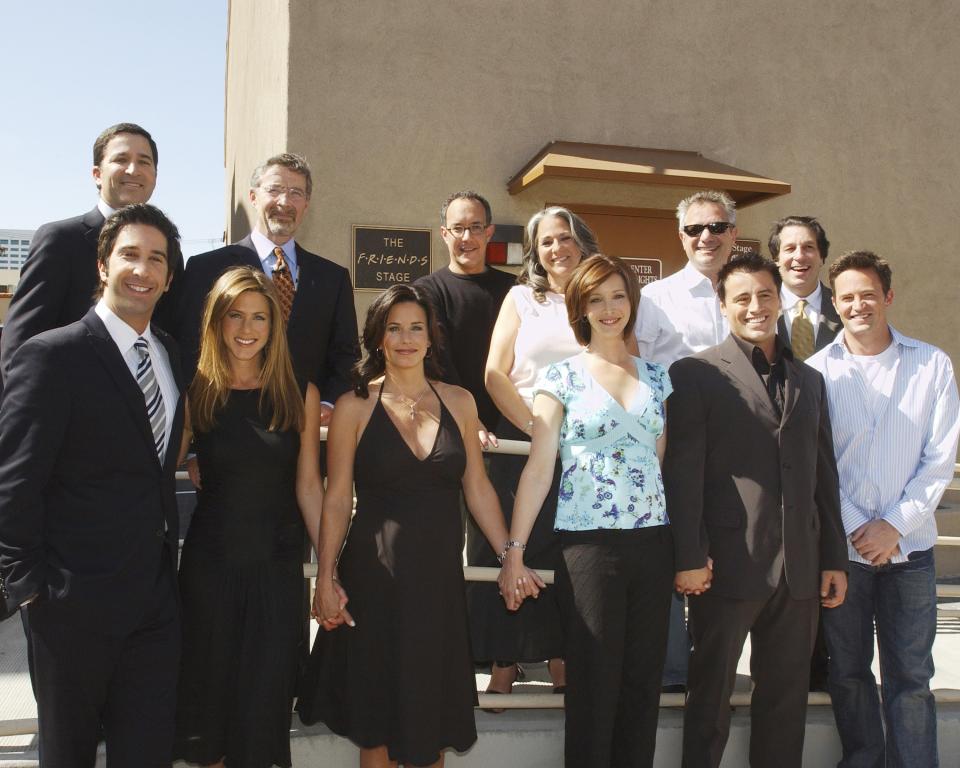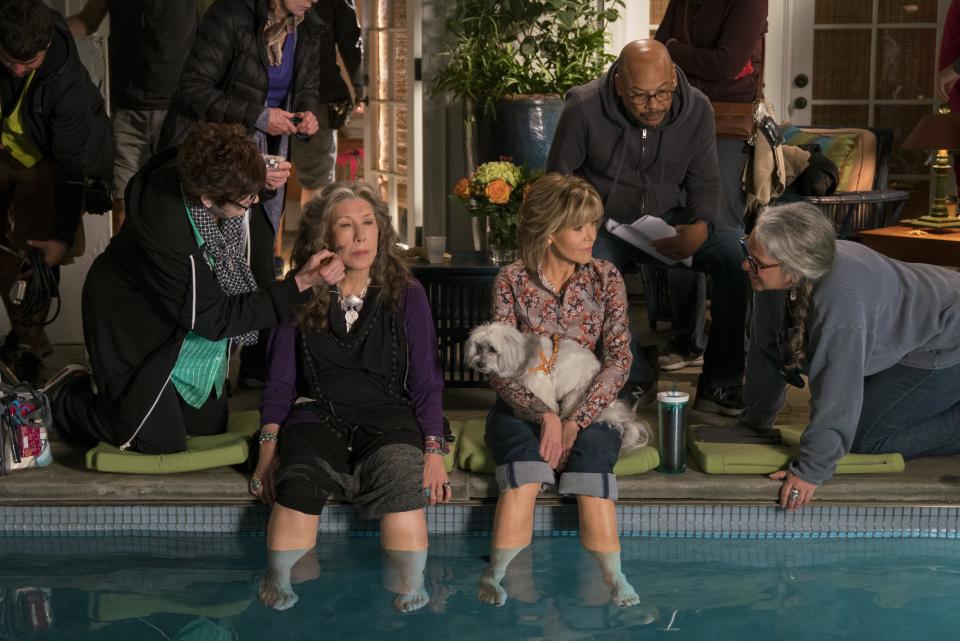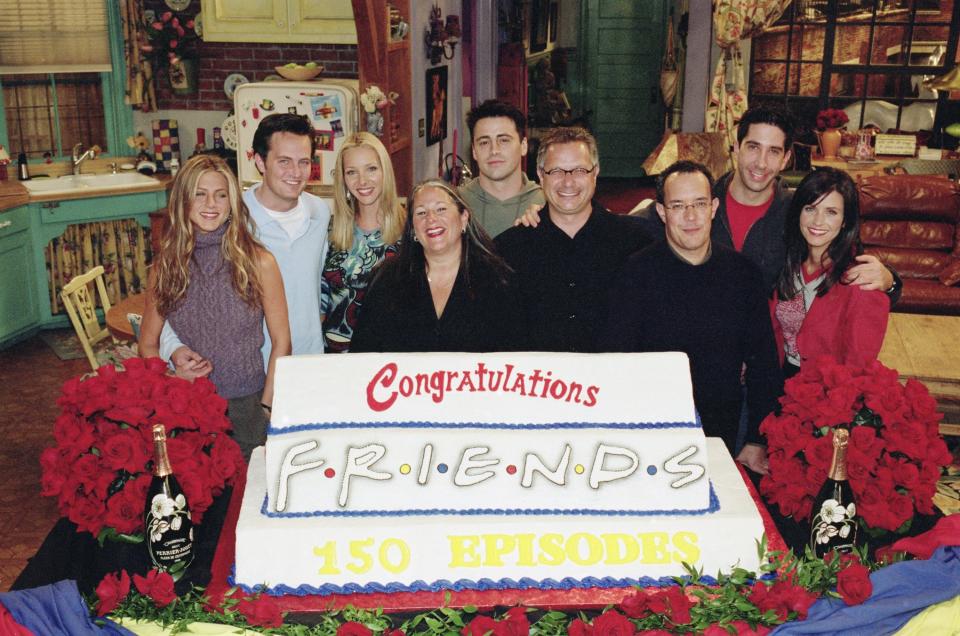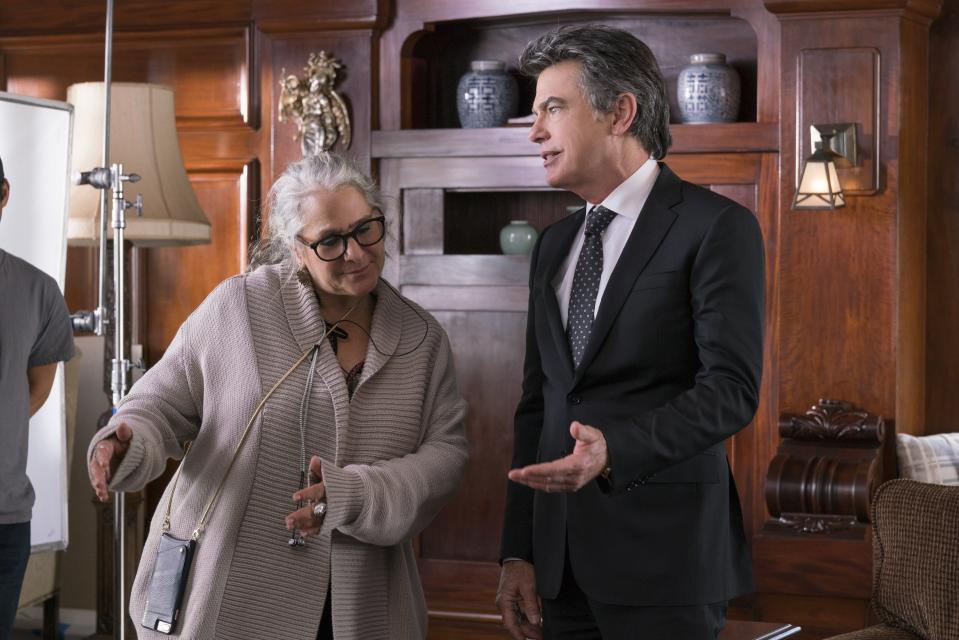Even Marta Kauffman Has Impostor Syndrome
During the final two weeks of filming Friends, cocreator and executive producer Marta Kauffman knit 14 hats. Kauffman, I learn, likes to keep her hands busy. One season she even carried around Silly Putty at all times. Having something in her hands served two purposes: “One of them is that it frees up my mind, and the other is that it keeps me from eating—because there’s so much crap in the writers room.” She pauses to laugh. “But I find it very liberating when I do that.”
Her writing process is just as tactile. Kauffman, 63, maps out episodes on a big board, using different-colored Post-it notes to represent each of her characters. On her latest hit, Netflix’s Grace and Frankie, Grace (Jane Fonda) is always red. Frankie (Lily Tomlin) is the complementary blue. So when their storylines sync up, she uses purple Post-it notes. The result: a collage in every hue.
Kauffman fills her office with these preoccupations—the aforementioned Silly Putty as well as snacks and adult coloring books—all forms of stress-relieving self-care. Look around and you’ll find even more clues into her personality: two gnomes flipping the bird, a ceramic penis fountain that Frankie made in an episode, and a cardboard unicorn. The only tribute to Friends comes in the form of a recently acquired Lego set of Central Perk. When she’s not in her office, she’s writing at her Malibu home—which the Grace and Frankie house is modeled after, except theirs is 15% bigger—with Law & Order: SVU humming in the background, and taking solitaire breaks between scenes to reset.

Friends
These days Kauffman is gearing up to get back in her writers room and pen the seventh and final season of Grace and Frankie, the story of two newly single women finding freedom and confidence in their later years. A show that Kauffman—a self-declared longtime sufferer of impostor syndrome—credits with helping her find her confidence and voice as a writer.
But Grace and Frankie’s swan song isn’t the only thing on Kauffman’s mind right now. This fall marks the 25th anniversary of the sitcom that enthralled Gen X-ers everywhere and changed Kauffman’s life forever: Friends. And the fever pitch of show’s cultural impact can be, well, overwhelming. This month alone the show will play in more than 1,000 theaters across the country, Warner Bros. has staged a pop-up of Central Perk and Monica’s apartment in SoHo, and Ralph Lauren launched a capsule collection inspired by the onetime Ralph Lauren employee Rachel Green (Jennifer Aniston). “There’s a part of me that wants to hide my head under a pillow,” she says of the Friends frenzy, “but the fact that it’s still relevant as pop culture is more the mark of success than anything else.”
Not all of the revisiting has been celebratory, though. While the show is meant to be consumed as comfort food, some of the snack-sized episodes have soured over the years. Those that focus on “fat Monica” or Chandler’s transphobia, for example. Kauffman says she’s not surprised about any backlash. “Because of it being on Netflix, you’re going to have people watch it and get caught up in it. You’re also going to have people criticize it. They come together, hand in hand.”

4
What’s more, “I don’t think they’re wrong about their criticisms," she says. "I wish I knew then what I know now. But I certainly understand some of the criticisms.” One particular plot line Kauffman regrets is Chandler’s “drag queen” father. “Kathleen Turner’s character, who we referred to as Chandler’s father. But she was a she. That was a big one,” she says.
Though Kauffman can now clearly see Friends for what it is, warts and all, for a long time she was trapped in the show’s weeds. Between 1994 and 2004 her world was Friends, 24/7. Rehearsals would begin at 10 in the morning. Depending on how it went, they’d start rewriting the script in the afternoon—with Kauffman employing her signature character color-coding as they doctored each version. (She’s even teased to Glamour before that her obsession with detail influenced the equally tactile Monica—the group’s resident control freak whose own version of hat knitting as a stress reliever is scrubbing her purple-painted apartment from top to bottom.)
Late nights, as in all-nighters, were par for the course. “I remember driving home [from work] with the sun coming up and getting my kids ready. Giving them breakfast, packing their lunch, and sending them to school,” she says. “Then I got dressed and went back to work. I’m not even sure I had time to take a shower.” (Kauffman says she made sure she never went two nights in a row without putting her kids to bed.) Despite the punishing schedule, she still found ways to have fun with the cast and crew. “There was a whole season of betting on what people could do. Could people stand through an entire rewrite? Or bets about who could eat what, by when, and how much,” she says. On Friday nights, after the show would tape, they’d end with a giant pizza party.
The juggernaut series cemented Kauffman as one of Hollywood’s most powerful female producers—and finally freed the writer, who was previously making $18,000 a year writing for a game show while caring for a baby, from the fear that she wouldn’t be able to pay her rent. But it wasn’t without its challenges. “I dealt with a great deal of misogyny. We would go into meetings, and the person would only look at my male partners and not even meet my eyes sometimes,” she says.

Friends
She continues, “I was—I am—a good producer. I have strong opinions, but I am kind, careful, and collaborative. But by many people I was called a bitch. Now I think I was just a strong producer—and they would never refer to the male producers I was partnered with as dicks.”
There was one particular incident that had a profound impact on Kauffman. The last Thursday of every season, she and cocreator David Crane would go out for dinner with the writers. It was during the very last writers dinner, at the tail end of the show’s final season, when they began reflecting on their run—and each other. “Everybody talked about everybody else, and they talked about what an amazing writer David was and how when if I said something’s wrong, something’s wrong.” Looking back, Kauffman doesn’t think this comment was made with malicious intent or had any underlying misogyny. But the comparison of Crane as a prolific writer, while she’s merely the person who “knew something was wrong,” stung. It also supported her a long-held fear: that she was an impostor. “What the writer said that night was a dagger in the heart of my impostor syndrome,” she says. “When I look at mistakes, missteps, or moments I can’t believe that I let go onscreen, I completely feel like an impostor. That if I were really good at what I did, I wouldn’t miss that.”
“To a certain extent I still feel it,” she says. “But I try not to let it takeover. And the way I do that is by keeping working.”
In a lot of ways, it was this unconscious desire to show the Friends team—and herself—she was a prolific writer that led her to create Grace and Frankie. It was her first series without her writing partner of 27 years, Crane, and the experience was emotional. “I remember on the very last night of the first season, breaking down just sobbing when I realized that I was trying to prove myself to the Friends writers,” she says. “It was such an overwhelming realization. In an odd way as much as it made me very productive, I think it was very unhealthy because the person I should’ve been trying to please was myself.”

4
With Grace and Frankie, Kauffman came to realize that she was not only a writer, but one with universal appeal. The kind of writer who could make the story of a septuagenarian odd couple be beloved both by the senior set and 20-somethings. “Netflix thought this would be watched by an older audience, and the fact that younger women came to it speaks to a few things,” she says. “One is that I believe that it’s aspirational. These two women are living life fully. They also tell the younger generation stuff they don’t know—and that they’re going to have to be prepared for. Things like dry vaginas. Losing pubic hair. The stuff that nobody tells you. The fact that these women talk about it with each other helps the subject be less taboo.”
Among the show’s millennial fans are Miley Cyrus, whose tweet, “I found my show! #GraceandFrankie. On a bender! Jane & Lily are so bad a$$,” helped get the show renewed, and Pete Davidson. The comedian’s rap—which featured cameos from Paul Rudd and DJ Khaled—about it on SNL included lyrics like, “My favorite TV show is motherfucking Grace and Frankie…. They’re opposites who run a business selling dildos, ain’t that classic!” And Kauffman credits Davidson’s sketch as the moment she felt like “the show had made it.”
As her first-ever solo vehicle winds down, Kauffman has an overwhelming feeling of pride. “I had the opportunity to really build emotional moments that helped me get in touch with the kind of writer I am,” she says of the series. “I’m all about wanting it to feel warm and welcoming to the audience, who is inviting [these characters] into their homes. I also discovered that I’m funnier than I think I am. I can think of moments throughout the course of the show, funny moments, that I am so proud of.”
Samantha Leach is the assistant culture editor at Glamour. Follow her on Twitter and Instagram @_sleach.
Originally Appeared on Glamour

